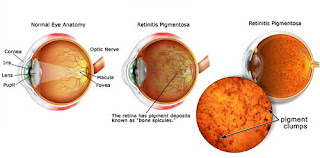What is Retinitis Pigmentosa?
Retinitis pigmentosa is an eye disease resulting from damage to the retina characterized by progressive loss of peripheral vision and night blindness and may lead to incurable blindness. It is a type of progressive retinal dystrophy and is a group of inherited disorders.
Picture 1: Difference between the normal eye and Retinitis pigmentosaaffected eye.
image source: williamsoneyeinstitute.com
Retina converts the light images to nerve signals and transmit it to the brain. This retina is found at the back of the inner eye responsible for the conversion. It is defined as light-sensitive tissue layer at the back of the inner eye and acts similar to the film of a camera in which images or lights are captures through the lens and focused on the retina.
The characteristic description of retina is red in color due to rich blood supply. Retina is considered part of the central nervous system and tissue of the brain which can be visualized non-invasively. It contains about 7 million of cones and consists of 75 to 150 million of rods.
Retinitis Pigmentosa Symptoms and Signs
Signs and symptoms of retinitis pigmentosa vary although common symptoms are such:Nyctalopia or night blindness is the first and common symptom of retinitis pigmentosa that is it considered as the hallmark of this inherited eye disease. Patient suffering from retinitis pigmentosa basically have difficulties walking or moving around dark or dimly lit rooms. The eyes take a long period of adjusting in the dark.
Picture 2: symptoms of Retinitis Pigmentosa in Eye
image source: news-medical.net
Peripheral vision loss or tunnel vision may be experienced often progressively. Patient often bumped into things that cannot be visualized on their periphery. They may bump into furniture or frames and other objects placed on their sides.
Photopsia or visions of flashing lights are seen by patients with retinitis pigmentosa. The flashing lights seen are described as small, shimmering and blinking lights.
Physical presentation of retinitis pigmentosa may be described as:
- Visual acuity is 20/20 to light perception until latter part of the disease.
- Pupil reaction can be normal with or without papillary defect.
- Posterior subcapsular cataracts may develop on the anterior segment.
Genetics
Multiple genetic mutations can lead to retinitis pigmentosa. Significant phenotypic variation has been identified as a result of many different genes leading to retinitis pigmentosa. This condition is one of the most common forms of inherited retinal degeneration.Genetic mutation of RP can be passed on from parents to offsprings through any of the three genetic inheritance patterns. Autosomal recessive pattern, parent carrying the gene can be asymptomatic but can have children affected with RP or others who may not be affected. Autosomal dominant pattern described as parent affected with RP and may or may not have affected offspring.
The X-link pattern, males are affected and females are the carriers. Affected males can pass it on to their female offspring making the female offspring carrier of the mutated gene in which the carrier can pass it on to the male offspring.
Diagnosis
Diagnosing RP depends on the documentation of family history by determining the mode of inheritance and progressive loss of photoreceptor cell function. DNA testing can be utilized in determining RP in mode of inheritance. Other diagnostic procedures that may be utilized are:- Opthalmoscopy – is an examination of the back of the inner eye which includes the retina after the pupils have been dilated
- Electroretinogram – is utilized in measuring the electrical activity in the retina
- Flourescein angiography – utilizing a special dye and camera to look at the blood flow in retina and choroid
- Visual acuity – is used in determining the smallest letter a person can read through the use of Snellen chart
- Intraocular pressure or tonometry – is used determining the pressure inside the eyes
- Slit-lamp examination – is used to view the structures at the front of the eyes
- Visual field test – is conducted to determine or measure the side or peripheral vision
Treatment
No effective treatment is currently available for retinitis pigmentosa. The condition can be overwhelming that better information, help and guidance to patient must be emphasized especially on the availability of therapies and visual devices to help them maximize the condition of their vision.Vitamin A palmitate is an antioxidant prescribed at 1500 IU daily intake can reduce the progression of the disease. Docosahexaenoic acid is an omega-3 polyunsaturated fatty acid and antioxidant also helps in reducing the rate of visual acuity.
Surgical intervention of removing the cataract is beneficial to patient in latter stage of retinitis pigmentosa. Corticosteroids are recommended in preventing postoperative cystoids macular edema prior to surgical procedure.
Research and Clinical trials
Retinitis pigmentosa research and advances are continually studying and developing therapies and other methods of treating RP. Daily supplement of Vitamin A antioxidant and Docosahexaenoic acid emerged to be effective in reducing the progression of the disease.Gene therapies are progressing through preclinical trials. The technology of gene therapy aimed in delivering corrective and therapeutic agents to rod and cone are being studied.
Researchers and scientists aimed to treat RP in the future through utilizing retinal transplant and artificial retinal implants. Other researches and studies involved gene therapies, stem cells, nutritional supplement and other pharmacotherapy in treating retinitis pigmentosa.


